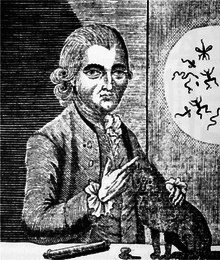Gustavus Katterfelto

Gustavus Katterfelto (or Katerfelto) (c. 1743-1799) was a Prussian conjurer, scientific lecturer, and quack.[1][2]
Career
Christian William Anthony Katterfelto (known as Gustavus) arrived at Hull in September 1776 and traveled around Britain until his death in 1799.[3] He performed in London from 1780-84. The widespread flu epidemic of 1782 made him famous as a quack, when he used a solar microscope to show images of microbes he believed were its cause.[4] These "insects" provided him with the catchphrase "Wonders! Wonders! Wonders!" which often headed his advertisements.[5] He lectured in Piccadilly on electricity, magnetism and the invented terms "styangraphy, palenchics, and caprimantic arts" to impress his audience.[6]
Katterfelto was an accomplished conjurer, who performed with a black cat which he advertised as "evil".[7] He claimed to have launched the first hot air balloon fifteen years before the Montgolfier brothers, and claimed to be the greatest natural philosopher since Isaac Newton.[8][9]
He performed on several occasions for the Royal family. The poet William Cowper refers to Katterfelto in The Task.
Katterfelto died in 1799 in Bedale, North Yorkshire where he is buried.[3]
References
- ↑ Maple, Eric. (1968). Magic, Medicine & Quackery. Hale. p. 124. "Best known of all late eighteenth-century quack buffoons was the mountebank Gustavus Katterfelto, the conjuror who employed a combination of legerdemain, pseudo-science, and clever publicity techniques to fascinate the public for a whole decade."
- ↑ Dawes, Edwin A. (1979). The Great Illusionists. Chartwell Books. p. 61
- 1 2 Walker, Andy (18 August 2008). "Insearch of a rogue who told tall tales". The Northern Echo. Retrieved 26 May 2018. (Subscription required (help)).
- ↑ Nash, Jay Robert. (2004). The Great Pictorial History of World Crime, Volume 2. Rowman & Littlefield. p. 364. ISBN 1-928831-20-6 "Gustavus Katterfelto launched a successful medical swindle. Passing himself off as a worldly philosopher and scientist, Katterfelto swindled Londoners with his sleight of hand tricks and medicine show for nearly three years. In 1872, he claimed to have invented the Solar Microscope, which he used to detect a deadly plague similar to the Black Death."
- ↑ Haslam, Fiona. (1996). From Hogarth to Rowlandson: Medicine in Art in Eighteenth-century Britain. Liverpool University Press. pp. 202-203. ISBN 0-85323-630-5
- ↑ Jameson, Eric. (1961). The Natural History of Quackery. Charles C. Thomas Publisher. pp. 62-64
- ↑ Paton-Williams, David. (2008). Katterfelto: Prince of Puff. Troubador Publishing. p. 81. ISBN 978-1906510-916
- ↑ Altick, Richard Daniel. (1978). The Shows of London. Harvard University Press. pp. 84-85
- ↑ Paton-Williams, David. (2008). Katterfelto: Prince of Puff. Troubador Publishing. p. 103. ISBN 978-1906510-916
Further reading
- Fara, Patricia. "Katterfelto, Gustavus (d. 1799)". Oxford Dictionary of National Biography (online ed.). Oxford University Press. doi:10.1093/ref:odnb/15187.
(Subscription or UK public library membership required.). The first edition of this text is available at Wikisource:

- Frost, Thomas. (1876). The Lives of the Conjurors. Tinsley.
- Paton-Williams, David. (2008). Katterfelto: Prince of Puff. Troubador Publishing. ISBN 978-1906510-916
- Williams, Neville. (1962). Rogues and Rascals in English History. Collier Books.
External links
- Attribution
